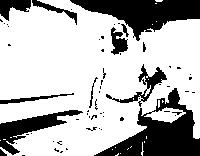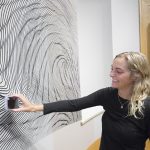
Curators Anne Collins Goodyear and Kathleen Campagnolo with Gina Guy, Collections Manager, at the Robert Rauschenberg Foundation, September 2012. In the background appears a detail of Robert Rauschenberg, Untitled (Scenario), 2006; inkjet pigment transfer on polylaminate, 85 1/2 x 120 1/2 inches (217.2 x 306.1 cm). Robert Rauschenberg Foundation, ©Robert Rauschenberg Foundation.
In 2009 we had the good fortune of intersecting at the Smithsonian Institution, where Kathleen Campagnolo and Jonathan F. Walz were pre-doctoral both fellows and Anne Collins Goodyear was on the curatorial staff at the Smithsonian’s National Portrait Gallery. Through separate projects, each of us had become intrigued by artists who were experimenting with alternatives to mimetic portraiture (or traditional portraiture representing figurative renditions of faces and bodies) at key moments during the past century. As we compared notes on our findings, realizing some of the most important American artists of the past 100 years were involved in creating these radical portraits, we were hooked! No one had ever assembled an exhibition on this topic before. We are grateful to the Smithsonian for a Scholarly Studies Grant that got our research underway and the Clark Art Institute’s Research and Academic Program for sponsoring an important research round table on the topic in 2013. Additionally, we are thrilled that the Henry Luce Foundation further contributed to this endeavor, when we decided to develop it as an exhibition at Bowdoin. We are appreciative of many other generous funders who helped support this important project, including Eric S. and Svetlana G. Silverman, Edward S. and Caroline H. Hyman, the Devonwood Foundation, halley k harrisburg and Michael Rosenfeld, Mary K. McGuigan and John F. McGuigan Jr., Thomas A. and Hannah Weil McKinley, Mary G. O’Connell and Peter J. Grua, the Cowles Charitable Trust, an anonymous donor, and the Roy A. Hunt Foundation.
The show has important resonance at Bowdoin, given the original research that has gone into it and the many different disciplinary traditions upon which it draws. This exhibition of abstract, conceptual, and symbolic art explores the emergence of new strategies for art making since the first decade of the twentieth century, but it also reflects new ways of thinking about the nature of the self. Today we may take for granted increasing fluidity in our personal expression and matters of gender, sexual, ethnic, and racial identity. That said, these shifts have occurred incrementally, and, of course, are still in flux. This Is a Portrait If I Say So interprets artistic expression in the context of social, political, technological, and scientific revolutions that have led to new ways of understanding ourselves.
The project has brought new insights to each of us, and we have had a great time as a team researching and preparing the accompanying catalogue for Yale University Press and planning for the upcoming exhibition. We are grateful to the many friends and colleagues at Bowdoin and beyond who have helped to make this possible!
Kathleen Campagnolo, Jonathan F. Walz, and Anne Collins Goodyear

